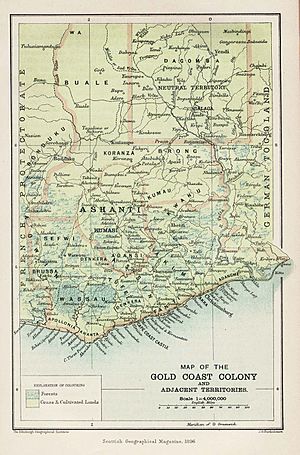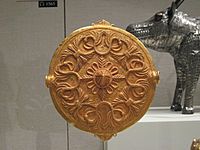Ashanti facts for kids
|
|
|||
| Total population | |||
|---|---|---|---|
| (Upwards of 10 million) | |||
| Regions with significant populations | |||
| Asanteman | |||
| Languages | |||
| Akan, Asante dialect | |||
| Religion | |||
| Akan, Islam, Christianity, Roman Catholicism, Non-religious and others | |||
| Related ethnic groups | |||
| Akan | |||
The Ashanti people, also called Asante (pronunciation: A-shahn-TEE), are a large group of the Akan people. They mostly live in a place called Asanteman, which is part of Ghana and Ivory Coast. They speak the Akan language and the Asante dialect.
Long ago, before Europeans came, the Ashanti built a big and powerful empire in West Africa. This empire was known as the Ashanti Confederacy or Asanteman. It became very strong in the region. The Asantehene is the main leader of the Ashanti people. He is important for both their government and their spiritual beliefs.
Contents
Where do the Ashanti live?
The Ashanti Region has different kinds of land. You can find coasts, mountains, forests, and grasslands. There are also rich farming areas. The Ashanti people settled in the central part of modern Ghana. This is about 300 kilometers from the Gulf of Guinea and the Atlantic Ocean.
The land is mostly covered in thick forests. It is very fertile and has some mountains. There are two main seasons. The rainy season lasts from April to November. The dry season is from December to March. During the dry season, the land can become very dry. It is hot all year round.

Today, there are about 10.5 million Ashanti people. Most of them (about 10 million) live in Asanteman. This area is now a sub-nation within Ghana. About 98.7% of the people in Asanteman speak Asante, also known as Twi. This language is part of the Niger–Congo language family.
The Ashanti people still have a lot of influence in Ghana. Kofi Agyekum Kuffour, a former UN ambassador, is an Ashanti. Kumasi is the capital city of Asanteman. It has also been the historic capital of the Ashanti Kingdom. The Ashanti region currently has a population of about 3.8 million people.
Ashanti Family Life
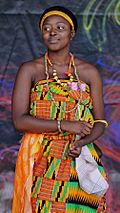
The Ashanti are a matrilineal society. This means that family lines are traced through the mother. In the past, this mother-child link decided who owned land. It also decided who would inherit property, important jobs, and titles.
However, the Ashanti also inherit some things from the father's side. Property inherited from the father is called "agyapade." This means "inheritance from a good father." A father's role was to give the child its nkra, or soul. This means the child got its life force, character, and personality from the father.
Historically, an Ashanti girl would get a golden ring called "petia" (meaning "I love you"). This would happen in childhood or after her puberty ceremony. Marriage, called "awade," was not seen as a big ritual event. Instead, it was a natural step after the puberty ritual. The puberty ritual was, and still is, very important. It shows that a child is becoming an adult. The boy's family would give gifts to the girl's family. This was not a "bride price." It was a sign of agreement between the two families.
Ashanti History
The Ashanti Kingdom
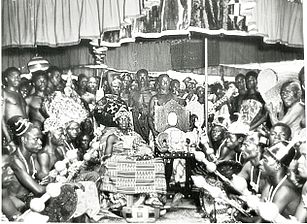
In the 1670s, the Ashanti changed from a small state to a strong kingdom. Osei Kofi Tutu I was a military leader. He was also the head of the Oyoko clan. He started the Ashanti kingdom. He got help from other clan chiefs. Using Kumasi as his base, he took control of nearby Akan states. He fought and defeated the Denkyira people in 1701.
Osei Tutu saw that a loose group of Akan states was weak. So, he made the government stronger. He also expanded the justice system. This way, small city-states grew into a large kingdom or empire. New areas that were conquered could join the empire. Or, they could become states that paid tribute. Opoku Ware I, who followed Osei Tutu, made the kingdom even bigger. It covered much of what is now Ghana.
Fighting European Colonizers
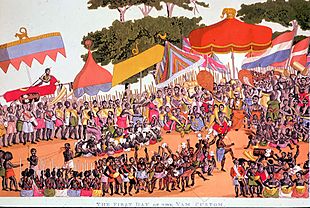
The Ashanti people fought hard against European attempts to take over. The British were the main ones trying to control them. The Ashanti limited how much influence the British had. Britain took over nearby areas. The Ashanti were known as strong and organized fighters. Their king could gather many warriors.
The Ashanti were one of the few African states that could truly resist European colonizers. Between 1823 and 1896, Britain fought four wars against the Ashanti kings. These were called the Anglo-Ashanti Wars. In 1901, the British finally defeated the kingdom. They made it part of their Gold Coast colony.
Because of their long history with European powers, the Ashanti have many written records. These records tell a lot about their past. The British even praised the Ashanti as a very civilized African people. They wrote about their religions, family life, and laws. One famous book was Ashanti Law and Constitution by R.S. Rattray.
Independence and Restoration
Later, relations between the Ashanti and the British got better. In 1926, the Ashanti were given back ceremonial control over Kumasi. By 1935, the full role of the Asantehene, the leader of the Ashanti people, was restored.
Ashanti Culture and People
The Akan people make up most of Ghana's population. About 57% of Ghana's people are Akan. The Ashanti are the largest subgroup of the Akan. They are estimated to be 60% to 70% of the Akan population. Former president John Kufuor is an Ashanti.
Ashanti culture celebrates several important festivals. These include Adae, Adae Kese, Akwasidae, Awukudae, and the Ashanti Yam Festival. Music is also very important. The Seperewa is a harp-like instrument with 10-14 strings. The fontomfrom drums are also very special to the Ashanti.
Religion
The Ashanti people practice several religions. These include Islam, the traditional Akan religion, and Christianity. Within Christianity, there are Catholic and Protestant followers. Some Ashanti people are also non-religious.
Images for kids
-
Asante male Kente clothing
See also
 In Spanish: Ashanti (desambiguación) para niños
In Spanish: Ashanti (desambiguación) para niños




